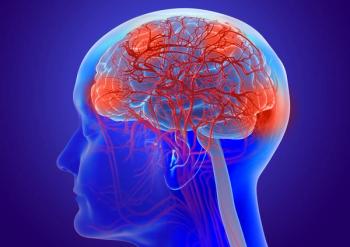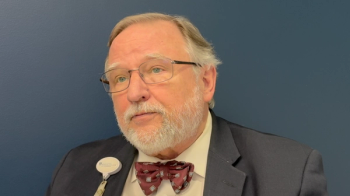
- ONCOLOGY Vol 12 No 11
- Volume 12
- Issue 11
A 54-Year-Old Woman With Recurrent Headaches and Seizures
The patient’s medical history is remarkable only for asthma and mild emphysema. The family history included a grandmother with gastric cancer. The patient had been taking estrogen replacement therapy since menopause 3 years earlier, and she was
Brian D. Kavanagh, MD: This tumor board conference will focus on the case of a 54-year-old woman with a 2-month history of headaches and seizures, who was diagnosed as having a primary brain tumor. The key features of the diagnostic work-up and management strategy will be presented, and relevant topics of ongoing basic research will be discussed. First, Dr. Manning will present the case history.
Matthew A. Manning, MD: The patient is a 54-year-old woman who pre-sented in December 1996 with a rightsided headache and generalized seizure. A magnetic resonance imaging (MRI) scan of the brain at that time was normal. In January 1997, the woman experienced another severe headache and a second seizure. Repeat radiographic imaging again was interpreted as normal, and anticonvulsants were started. Her headaches continued to worsen, and an MRI performed in February 1997 revealed a right frontal enhancing brain mass that appeared to be a primary brain tumor.
The patients medical history is remarkable only for asthma and mild emphysema. The family history included a grandmother with gastric cancer. The patient had been taking estrogen replacement therapy since menopause 3 years earlier, and she was allergic to peroxide.
The patient is married and has three healthy children. She works full time in the family business. She smoked one to two packs of cigarettes daily for 30 years, but she quit smoking 3 years previously. She does not drink alcoholic beverages or use illegal drugs.
A review of systems revealed no complaints other than the previously noted neurologic symptoms. Karnofsky performance status was 90. Physical examination, including a detailed neurologic examination, was entirely normal for a woman of her age in generally good health. Laboratory studies, including a complete blood count and serum chemistries, were normal, and a chest radiograph demonstrated no infiltrates or mass lesions.
On March 11, 1997, the patient underwent a right frontal craniotomy with gross total resection of what was identified histopathologically as a glioblastoma multiforme. There were no postoperative complications or neurologic deficits.
The patient was then enrolled on the Massey Cancer Center 96-12 protocol, through which she received 50 Gy of wide-field, conventionally fractionated external-beam radiotherapy, followed by 24 Gy administered via four weekly concomitant stereotactic boost treatments, for a total of 74 Gy to the tumor bed. The patient has also received three of four planned cycles of carmustine (BCNU [BiCNU]) therapy, administered intravenously at a dose of 80 mg/m²/d for 3 days every 8 weeks.
Dr. Kavanagh: Dr. Pizzuti, this patient underwent several radiographic imaging studies shortly before the lesion was recognized. Please comment on whether, in retrospect, there were any irregularities on the initial radiographic studies that might have suggested the diagnosis earlier. Also, are there any other processes that could cause such a dramatic change on an MRI within such a short period?
Thomas Pizzuti, MD: Although the MRI obtained in December 1996 did contain a small periventricular area of abnormality, possibly related to prior ischemia, there was no evidence of a lesion in the area later seen to be involved by the mass (Figure 1a). The study obtained in January 1997 was similarly unremarkable.
It is obviously quite disturbing that such a large, enhancing mass in the right frontal lobe region was seen just 2 months later (Figure 1b). This lesions rapid progression and pattern of central necrosis are highly suggestive of a high-grade primary brain tumor, but the differential diagnosis would also include a metastatic lesion from another malignancy and an infectious process forming an abscess.
A follow-up MRI study also is available for comparison. The right frontal region is notable for the expected postoperative changes, but there is no evidence of recurrent tumor (Figure 1c).
Lisa A. Kachnic, MD: Dr. Broaddus, what do you consider to be the standard of care for managing patients with glioblastoma multiforme? What are the effects of recent advances in neurosurgical technology?
William C. Broaddus,MD, PhD: In general, the primary radiographic contrast-enhancing tumor and any associated necrotic tissue should be resected as completely as possibly without causing significant postoperative neurologic deficits, and adjuvant therapy should be given to all patients. Numerous reports have indicated that, the greater the extent of tumor resection, the better is patient survival. Also, the surgeon should minimize the amount of normal surrounding brain tissue that is removed in the process. In this particular case, the tumor was actually in a favorable site for an attempt at extensive resection, since it was peripherally located away from deeper critical structures.
Stereotactic Localization Technology
Recent advances in neurosurgical technology have not really changed the basic principles of management of glioblastoma multiforme. The goals of management remain the same, and adjuvant therapy is still recommended in all cases. However, the recently developed technology for intraoperative stereotactic localization is particluarly helpful in allowing a surgeon to be much more aggressive in marginal cases in which a tumor may approach critical structures without yet invading them.
The primary determinant of a tumors resectability remains its location within the brain, and obviously there is no way to change that. However, with stereotactic localization technology, the tumors relationship to surrounding structures can be seen much more clearly than before.
The system essentially translates the three-dimensional tumor imaging data from the preoperative MRI and gives the surgeon real-time feedback during surgery about the location of the scalpel within the head relative to the tumor. For cases in which the tumor closely approximates critical structures, such as the optic apparatus or brainstem, the surgeon can be more confident about scalpel position and, thus, can resect more of the tumor adjacent to these structures.
Even in a case such as this one, where the tumor is in a relatively favorable location, stereotactic localization still provides an important technical advantage. In this particular case, because such accurate knowledge of tumor location was available, I could approach the tumor directly through a more limited incision and craniotomy. Consequently, I could minimize the amount of surrounding normal brain tissue resected during the procedure.
Correlation Between MRI and Surgical Findings
Dr. Kachnic: How well does the MRI appearance actually correlate with findings during surgery? Can the surgeon really detect a difference in texture between areas of the brain near the tumor that look edematous and areas that look normal?
Dr. Broaddus: It is amazing how closely the surgical findings correlate with the MRI findings when the stereotactic system is being used. In a typical patient with glioblastome multiforme, the major abnormality on the scan is the enhancing lesion, which is surrounded by brain that appears edematous. Currently, I use an incremental surgical technique whereby I remove a layer of tumor and then assess my location, especially if I am approaching an area where there would be significant adverse effects on neurologic function from injury to the normal brain. After Ive gone past the relatively firmer areas of tumor, I typically break through into white matter that has a very watery appearance and that, in fact, often is even visibly weeping fluid.
I should acknowledge that some surgeons do not feel comfortable relying on stereotactic technology to guide them into deeper resections because they recognize that once a surgical procedure is underway, the brain anatomy is different from what was seen on the preoperative MRI because tissue is being moved and removed. However, I generally find that the system gives me very good information to help me remain aware of the three-dimensional anatomy.
Dr. Kachnic: Dr. Cardinale, what do you consider to be the standard postoperative treatment for glioblastoma multiforme? Is there any role for specialized techniques, such as stereotactic radiosurgery or brachytherapy?
Robert M. Cardinale, MD: The recommended postoperative therapy for patients with glioblastoma multiforme consists of external-beam irradiation (approximately 40 to 45 Gy) given to the preoperative tumor volume plus surrounding edema, followed by boost treatment to the preoperative enhancing tumor volume. The initial fields are usually arranged as opposed right and left lateral fields, although it is always best to individualize the treatment set-up if an alternative plan could deliver the same dose to the tumor and more effectively spare normal tissues. The boost fields typically encompass the preoperative enhancing tumor volume plus a smaller margin of approximately 2 cm. Throughout the course, the dose is administered in fractions of 1.8 to 2 Gy, and the total dose is approximately 60 Gy.
The addition of BCNU chemotherapy should be strongly considered for patients with good performance status because there is some evidence that it modestly improves 2-year survival. The standard dose is 80 mg/m² given every 8 weeks, starting during or shortly after radiotherapy.
Role of Radiosurgery and Brachytherapy
Both radiosurgery and brachytherapy have the same goal: to escalate the dose to any residual gross tumor or to areas adjacent to the tumor bed considered to be at high risk for microscopic tumor infiltration. These specialized techniques have been evaluated in several phase II trials, with encouraging results.
To achieve dose escalation, we favor the use of multiple stationary conformal fields to treat the entire tumor bed rather than pure radiosurgery, which involves smaller rotating fields to focus on a high-risk area or residual tumor. For any given patient, it is possible to compare radiosurgery with multiple stationary-field conformal radiotherapy by calculating the relative distribution of radiotherapy dose in normal and tumor tissue using either technique.
For all but the smallest tumor bed regions, I usually find it advantageous to use the conformal techniques because they provide more dose within the tumor relative to the surrounding normal brain tissue. However, in some cases, I give the boost dose with a variation of radiosurgery known as fractionated stereotactic radiotherapy, which essentially corresponds to repeated radiosurgery treatments using a removable head frame localizer.
At present, however, I think that the use of all of these investigational techniques--high-dose conformal radiotherapy, radiosurgery, and brachytherapy---should be restricted to formal clinical protocols.
Dr. Broaddus: There is another important consideration in the ongoing management of patients with glioblastoma multiforme following initial therapy administered at the time of diagnosis. Patients who develop recurrent disease after surgery and postoperative adjuvant therapy should be evaluated for possible re-resection with placement of a Gliadel wafer. It can even be argued that this represents a new component in the standard of care for the management of this tumor.
The Gliadel wafer is a method of delivering additional local therapy in the form of an implantable polymer wafer containing carmustine. The polymer degrades as the chemotherapy is released locally. Randomized studies showing a small survival benefit with this approach led to its approval by the FDA. Since a therapeutic option is now available for some patients at the time of recurrence, I believe that one can justify performing follow-up imaging studies every 2 to 3 months to look for early evidence of tumor regrowth.
Distinguishing Glioblastoma Multiforme From Other Tumors
Dr. Kavanagh: Dr. Amaker, what other brain lesions can mimic glioblastoma multiforme microscopically?
Barbara H. Amaker, MD: The term "glioblastoma multiforme" implies that the tumor originates in glial tissue but can manifest a varied appearance. The individual tumor cells can range from small, round, blue cells to spindle-shaped or even giant multinucleated cells, to name only a few possibilities. Many tumors can resemble a glioblastoma multiforme, especially poorly differentiated metastatic carcinoma, melanoma, lymphoma, and even some sarcomas.
Within the category of glial tumors, the diagnosis of glioblastoma multiforme is based on four key criteria used to grade the tumor: vascular proliferation, mitotic activity, pleomorphism, and necrosis. If three or more of these characteristics are present, the diagnosis can be made.
In this case, an intermediate-power view revealed obvious vascular proliferation (Figure 2a), and one could even see red blood cells in areas of blood vessel formation. Using a higher power of magnification, mitotic figures were visible, as well as pleomorphism, with some very large cells with vesicular nuclei mixed with some small cells with dark blue nuclei (Figure 2b). Areas of necrosis were noted in other sections (Figure 2c); this feature is nearly always present in high-grade glioma.
Overexpression of EGF-R and TP53 Mutations
Dr. Kavanagh: It has been reported that subsets of glioblastoma multiforme have an increased expression of epidermal growth factor receptor (EGF-R). What effect, if any, do alterations in EGF-R expression have on the histologic appearance?
Dr. Amaker: First, EGF-R overexpression, itself, cannot be detected with routine histologic stains, but rather, only through special immunoperoxidase stains. Glioblastoma multiforme can arise de novo as a primary lesion or as a secondary transformation of a lower-grade glioma. Overexpression of EGF-R can frequently be detected in a de novo glioblastoma multiforme but is rare in glioblastoma multiforme that arises from a low-grade glioma. Conversely, mutations of TP53 (alias p53) often can be detected when glioblastoma multiforme arises as a secondary lesion, whereas the incidence of TP53 mutations is very low among de novo tumors. Routine histologic staining shows no obvious difference between de novo glioblastoma multiforme and the secondary type.
Prognosis
Dr. Kachnic: Dr. Cardinale, what is this patients prognosis?
Dr. Cardinale: The Radiation Therapy and Oncology Group (RTOG) has analyzed a large database of patients with brain tumors, including many with glioblastoma multiforme. Based on this analysis, the RTOG has classified patients into subgroups according to key clinical features, such as age, extent of tumor resection, and performance status, all of which impact upon prognosis.
Given that this patient is relatively young, that she had a gross total resection, and that she had an excellent postoperative performance status with no neurologic deficits, she would fit into the most favorable category of patients with glioblastoma multiforme. Nevertheless, the median survival of this subgroup of patients is still only approximately 11 months.
Dr. Kavanagh: Dr. Ginder, what do you consider to be the top priorities for future research on the management of patients with glioblastoma multiforme?
Gordon Ginder, MD: First, I would emphasize that although limited progress has been made in the treatment of this disease, the survival time for most patients is still only in the range of weeks to months. The oncology community has not yet achieved nearly as much success in the treatment of this disease as in many other solid tumors. Recent technical advances in surgery and radiotherapy have led to rather small incremental improvements in outcome, and adjuvant chemotherapy has had only a modest impact on survival times at best.
Clearly, we need to develop better treatments for this disease. What is needed most are intensified efforts in preclinical research on glioblastoma multiforme so that we can gain greater insights into the mechanisms by which normal brain tissue becomes malignant and proliferates so rapidly. There is certainly room for creativity to devise new strategies for arresting this process at any point along the way, from initial genetic mutations, to the production of abnormal amounts and types of growth-regulatory proteins, to angiogenesis and invasion into adjacent tissues.
Obviously, this type of basic research has to be followed by carefully designed clinical trials to translate the findings into tolerable and effective combinations with standard therapy. However, it is only through continued basic research into the fundamental aspects of the biology of glioblastoma multiforme that we can ever expect major breakthroughs in treatment.
Dr. Kachnic: Dr. Broaddus, from your own laboratory work and that of others in the field, what approaches would you predict will provide the most substantial clinical advances in the future?
Gene-Directed Therapies
Dr. Broaddus: I agree with Dr. Ginder that the spectrum for potentially helpful innovative approaches to high-grade gliomas is quite broad. There are some promising initiatives examining new gene-directed therapies to target the tumors, as well as exploring innovative techniques to deliver this and other types of treatment.
A tremendous amount of information is accumulating about precisely how certain sequential gene mutations correlate with stepwise increases in the virulence of a glioma as it progresses from lower- to higher-grade histopathology. There are both gain-of-function mutations, such as amplification and/ormutation of EGF-R, which lead to unrestrained cell proliferation, and loss-of-function mutations, such as mutations of the TP53 tumor-suppressor gene, which likewise cause tumor cell growth.
Investigators in our laboratory and others around the world have been studying how to reverse the TP53 mutation to reconstitute tumor-suppressor gene activity. One interesting observation that we have made in a rodent tumor model is that adenoviral vectors can be used to introduce the normally functioning wild-type TP53 gene into tumor cells to cause a significant decrease in tumor growth. Also, since we know that TP53 influences the cellular response to radiation therapy, we have also demonstrated that transfection of this gene into tumor cells makes them more radiosensitive and promotes apoptosis, or programmed cell death.
Another clever approach currently under investigation at numerous centers is to try to introduce the herpes simplex virus-thymidine kinase (HSV-TK) gene into tumor cells. This gene produces a certain enzyme that can render cells highly susceptible to gancyclovir (Cytovene) treatment. Encouraging data support this therapeutic approach to gliomas and several other solid tumor cell lines.
Overcoming the Blood-Brain Barrier
Another area of investigation focuses on the delivery of therapies to brain tumor cells. The blood-brain barrier can be a formidable obstacle to all types of systemic therapy. One strategy to overcome this barrier is to attach cytotoxic agents to antibodies to cell surface receptors. We are currently participating in a multicenter trial evaluating this so-called immunotoxin therapy. The particular agent being tested is a conjugate between a transferrin receptor antibody and a modified diphtheria toxin. The antibody binds to the cell surface and acts as a "Trojan horse" to provide access for the toxin, which can then cause the death of the tumor cells. We have treated a number of patients on this protocol, and the results are very promising so far.
Dr. Kavanagh: Dr. Cardinale, how well did this patient tolerate therapy? What would be the typical acute and late toxicities from the type of treatment that she received?
Dr. Cardinale: The protocol on which this patient was treated is a dose-escalation study involving three-dimensional conformal techniques. According to this protocol, she received a total of 74 Gy, the first 50 Gy of which were delivered as conventional fractions of 2 Gy. Subsequently, she received four weekly fractions of 6 Gy to the final boost volume.
The patient tolerated this therapy very well. She remained an outpatient, worked nearly full-time, actually commuted about an hour each day to receive treatment, and experienced no significant acute side effects. To date she has had no late side effects.
The expected acute side effects from radiation include hair loss and skin irritation. Some patients with gliomas must be treated through fields that are near or through the ear, and patients so treated may experience difficulty with hearing, although usually only temporarily. Also, some patients who receive radiation to the brain develop a somnolence syndrome that can last anywhere from 1 to 4 months after radiation. This complication, which can be manifested by lethargy, can mimic tumor progression.
The most important late effect of radiotherapy for gliomas, which can occur 6 months or more after treatment, is radionecrosis of the surrounding normal brain tissue. One challenge faced by clinicians is distinguishing radionecrosis from recurrent glioblastoma multiforme, which often appear identical radiographically. Frequently, both residual tumor and radionecrosis are present simultaneously.
Typically, with conventional doses of approximately 60 Gy administered via standard techniques, the incidence of radionecrosis should be £ 5%. In a dose-escalation study, one risks increasing the incidence of radionecrosis to achieve a delay in the recurrence of tumor.
In June 1998, the patient was seen for follow-up. She was still working full time, and an MRI was unchanged from prior studies. Unfortunately, in late July she began to have headaches and ataxia. An MRI performed in August 1998 revealed a recurrence in the right posterior parietal lobe (Figure 3) outside of the area of high-dose irradiation. The patient died from progression of this lesion 1 month later.
Articles in this issue
about 27 years ago
Phase III Results of Second-Generation HIV Protease Inhibitor Reportedabout 27 years ago
Telomerase Rejuvenates Cells Without Causing Malignant Transformationabout 27 years ago
Hoechst Marion Roussel Launches Antiemetic Information Centerabout 27 years ago
Telomerase Rejuvenates Cells Without Causing Malignant Transformationabout 27 years ago
Intraoperative Ultrasound-Guided Cryoablation of Renal Tumorsabout 27 years ago
First Doris Duke Clinical Scientist Awards Announcedabout 27 years ago
Phase III Results of Second-Generation HIV Protease Inhibitor ReportedNewsletter
Stay up to date on recent advances in the multidisciplinary approach to cancer.




![According to John Henson, MD, “What we need are better treatments to control the [brain] tumor once it’s detected.”](https://cdn.sanity.io/images/0vv8moc6/cancernetwork/e0d29c38bb732429ae370e4ef7d1829a10c96446-2992x1684.png?w=350&fit=crop&auto=format)












































































